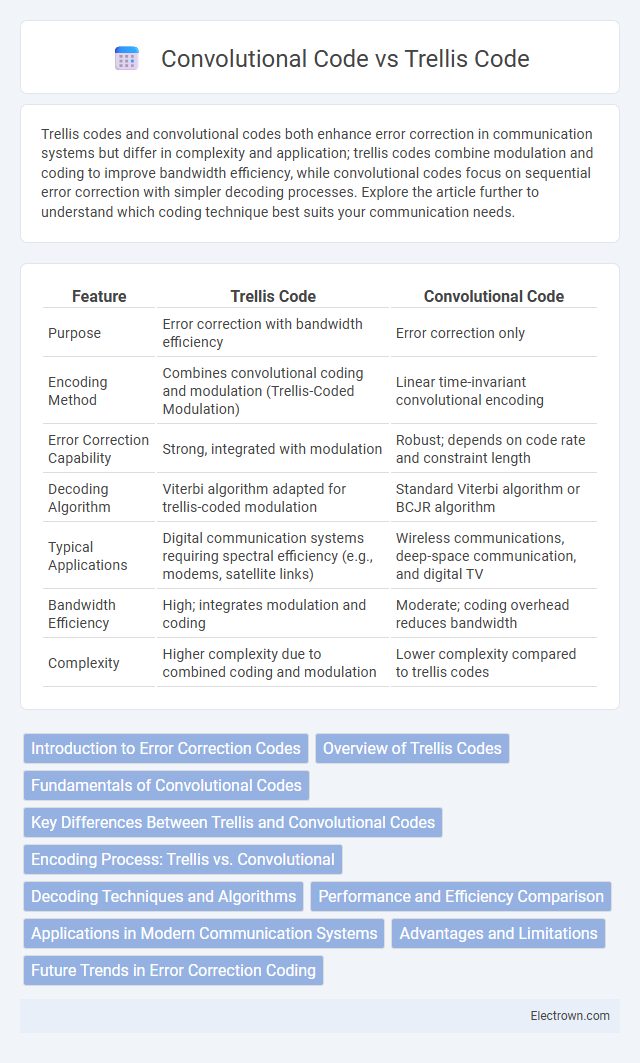Trellis codes and convolutional codes both enhance error correction in communication systems but differ in complexity and application; trellis codes combine modulation and coding to improve bandwidth efficiency, while convolutional codes focus on sequential error correction with simpler decoding processes. Explore the article further to understand which coding technique best suits your communication needs.
Table of Comparison
| Feature | Trellis Code | Convolutional Code |
|---|---|---|
| Purpose | Error correction with bandwidth efficiency | Error correction only |
| Encoding Method | Combines convolutional coding and modulation (Trellis-Coded Modulation) | Linear time-invariant convolutional encoding |
| Error Correction Capability | Strong, integrated with modulation | Robust; depends on code rate and constraint length |
| Decoding Algorithm | Viterbi algorithm adapted for trellis-coded modulation | Standard Viterbi algorithm or BCJR algorithm |
| Typical Applications | Digital communication systems requiring spectral efficiency (e.g., modems, satellite links) | Wireless communications, deep-space communication, and digital TV |
| Bandwidth Efficiency | High; integrates modulation and coding | Moderate; coding overhead reduces bandwidth |
| Complexity | Higher complexity due to combined coding and modulation | Lower complexity compared to trellis codes |
Introduction to Error Correction Codes
Trellis codes and convolutional codes belong to the class of error correction codes used to improve data transmission reliability over noisy communication channels. Trellis codes combine convolutional encoding with modulation schemes, optimizing bandwidth efficiency and minimizing error rates by representing possible encoded sequences as paths through a trellis diagram. Convolutional codes encode data streams continuously using shift registers, enabling real-time error detection and correction through algorithms like the Viterbi decoder, essential for digital communication systems requiring robust error resilience.
Overview of Trellis Codes
Trellis codes combine convolutional coding with modulation schemes to improve error correction and spectral efficiency in digital communication systems. They use a finite-state machine representation to map input bits into coded symbols, allowing maximum likelihood decoding via the Viterbi algorithm. This method enhances signal robustness against noise and interference, making trellis codes essential for reliable high-speed data transmission.
Fundamentals of Convolutional Codes
Convolutional codes encode data by passing input bits through shift registers combined with generator polynomials, creating coded sequences that provide error correction capabilities. These codes are represented using trellis diagrams, which illustrate state transitions and output sequences, facilitating efficient decoding with the Viterbi algorithm. Understanding the fundamentals of convolutional codes enables your communication system to improve data integrity in noisy channels through continuous encoding and real-time error detection.
Key Differences Between Trellis and Convolutional Codes
Trellis codes integrate modulation and coding by mapping input bits onto signal constellation points, utilizing a trellis diagram for efficient maximum likelihood decoding, while convolutional codes apply sequential processing to input bits with shift registers and generate output through convolution operations. Trellis codes achieve higher spectral efficiency by combining coding and modulation, optimizing error performance for bandwidth-limited channels, whereas convolutional codes primarily focus on error correction with decoder complexity growing exponentially with constraint length. The fundamental distinction lies in trellis codes' embedded modulation scheme versus convolutional codes' standalone error correction capability, influencing system design and decoding strategies in digital communication systems.
Encoding Process: Trellis vs. Convolutional
The encoding process of Trellis code involves mapping input bits into multidimensional signal points based on a trellis diagram, combining modulation and error correction to increase data rate and reliability. In contrast, Convolutional code encoding processes input bits through shift registers and linear combiners, generating encoded output streams that can be decoded using algorithms like Viterbi for error correction. Your choice between these codes depends on the trade-off between complexity and performance in communication systems.
Decoding Techniques and Algorithms
Trellis codes are decoded primarily using the Viterbi algorithm, a maximum likelihood decoding technique that efficiently finds the most likely transmitted sequence by traversing the trellis diagram. Convolutional codes also utilize the Viterbi algorithm for decoding due to its optimal performance in correcting errors caused by noisy channels. Both coding schemes rely on trellis structures for encoding and decoding, but trellis-coded modulation combines coding with modulation to improve bandwidth efficiency while convolutional codes focus on error correction robustness.
Performance and Efficiency Comparison
Trellis codes offer enhanced error correction by combining coding with modulation, leading to improved bandwidth efficiency and lower bit error rates compared to conventional convolutional codes. Convolutional codes excel in simplicity and decoding speed, but trellis-coded modulation provides superior performance in noisy channels by leveraging signal constellation structures. Your choice depends on whether your priority is maximizing error resilience with trellis codes or benefiting from the computational efficiency of convolutional codes.
Applications in Modern Communication Systems
Trellis codes are extensively used in high-speed digital communication systems like DSL and wireless networks to improve error performance without increasing bandwidth. Convolutional codes serve as a foundational element in cellular networks and satellite communications due to their robust error correction capabilities and real-time decoding efficiency. Both coding schemes enhance data reliability in 4G, 5G, and deep-space communication by facilitating efficient error detection and correction under noisy channel conditions.
Advantages and Limitations
Trellis codes offer enhanced error correction by combining coding and modulation, improving bandwidth efficiency and robustness in noisy channels, but their complexity increases significantly with longer constraint lengths. Convolutional codes provide effective error detection and correction with relatively simpler encoding and decoding processes, making them suitable for real-time applications, but they often require higher redundancy and may underperform in highly noisy environments compared to trellis-coded modulation. The choice between trellis code and convolutional code depends on system requirements for complexity, bandwidth efficiency, and error performance.
Future Trends in Error Correction Coding
Future trends in error correction coding emphasize enhanced Trellis code designs integrating machine learning techniques for adaptive decoding, improving efficiency in dynamic communication environments. Advances in convolutional code algorithms focus on optimizing hardware implementation and reducing decoding latency, crucial for 5G and 6G wireless networks. Research explores hybrid error correction schemes combining Trellis and convolutional codes to balance complexity and error performance in next-generation data transmission systems.
Trellis code vs Convolutional code Infographic

 electrown.com
electrown.com